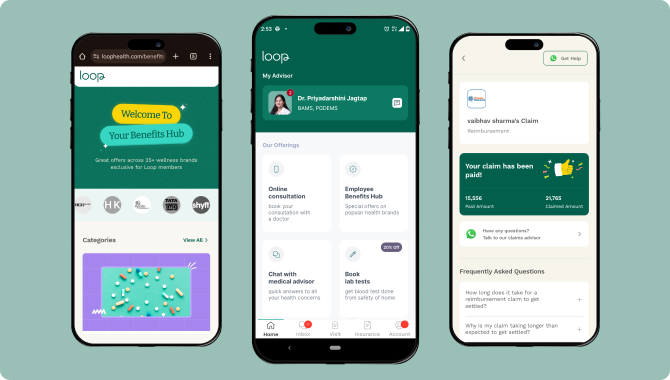The Changing Landscape of Employee Health in India
India’s workforce carries a dual health burden: limited infrastructure and rising lifestyle diseases. Noncommunicable diseases now account for about 64% of all deaths in India, with one in four Indians at risk of an NCD-related death before age 70. Most of these cases are preventable with early intervention.
In tier-1 and tier-2 cities, employees face long waits, limited specialist access, and high out-of-pocket costs. With lifestyle conditions driving the majority of diseases and pushing claims higher, prevention and OPD-level care are the only sustainable solutions for employers.
This dual challenge makes it clear that companies can no longer rely on reactive insurance alone.
Traditional insurance engages only once an employee, or their family, is already sick—leaving a gap in the benefits ecosystem. A gap that prevention-first brokers are designed to close.
{{divider}}
3 Critical Gaps in Traditional Health Insurance Brokerage
Most Indian companies still work with conventional insurance brokers. These brokers play an important role in arranging group policies and assisting with claims, but their model has three clear limitations in today's health environment:
- Transactional Engagement: Brokers are visible mainly during enrollment and when a claim is filed through the TPA or insurer. For the 90%+ of employees who never use their insurance in a given year, the benefit feels invisible.
- Reactive by Design: Their value appears only after hospitalization. Prevention, early detection, and day-to-day health support fall outside their scope.
- Lack of Integrated Care: Traditional brokers don't employ doctors, run health programs, or provide wellness analytics. They manage policies, not health outcomes.
For HR leaders and CFOs, this creates frustration. Benefits budgets grow each year due to medical inflation, yet claims keep rising, and employee health doesn't improve. Employees, meanwhile, feel their benefits are irrelevant until a crisis hits.
{{divider}}
How IRDAI's 2020 Wellness Guidelines Changed the Game for Employers
While the pain is clear, India's regulatory and policy environment is now pushing employers toward prevention:
IRDAI's 2020 Wellness and Preventive Guidelines: Allow insurers to reward preventive behavior through premium discounts, higher sum insured, and partnerships with health providers.
Tax Incentives (Section 80D): Deductions of up to ₹1 lakh for health coverage, including ₹2,000 for preventive check-ups. Employer-provided screenings and wellness programs qualify as deductible expenses.
National Health Policy 2017: Explicitly prioritizes "preventive and promotive healthcare" in development planning.
Together, these reforms transform prevention from a cost center into a value driver, helping organizations both improve employee health and negotiate stronger insurance terms.
{{divider}}
What Is Prevention-First Health Insurance? Understanding the 3-Pillar Model
Prevention-first brokers, also known as health assurance brokers, integrate three pillars into one model:
- Prevention: 24/7 medical access, routine screenings, mental health support, and proactive programs for high-risk conditions like diabetes, hypertension, and stress.
- Protection: Transparent, reliable insurance that activates when needed, with smooth claims processes.
- Care: Integrated primary care and specialist networks, so employees can move seamlessly from symptom to solution.
The result is a system where each element strengthens the others. Early medical support reduces claims, smoother claims reduce HR escalations, and healthier employees improve productivity.
{{divider}}
Side-by-Side: Traditional vs. Prevention-First Health Insurance Brokers
4 Measurable Benefits of Prevention-First Health Insurance
For CHROs and CFOs, the prevention-first model delivers tangible strategic and financial returns:
1. Lower Claims Reduce Insurance Premiums
FICCI-Feedback Consulting research from December 2015 shows that 44.3% of hospitalization cases could have been prevented by early detection and simple preventive action covered under OPD. Preventive care reduces the incidence of costly hospitalizations. Catching hypertension early, for instance, prevents strokes and cardiac events. Over time, companies with healthier employee populations see fewer high-value claims, which stabilizes renewal premiums.
Organizations adopting preventive care programs report 26% lower healthcare costs, with ROI ranging from 2:1 to 21:1.
2. Cut Employee Absenteeism by 27% Through Preventive Care
NCD-related productivity loss is projected to cost India $6.2 trillion by 2030. Companies implementing structured preventive programs see a 27% drop in absenteeism, translating directly to improved workforce productivity and business continuity.
3. Improve Retention with Health Benefits Employees Actually Use
Employers offering integrated, preventive health benefits build reputations as caring organizations. Research indicates that employees are far more likely to stay with a company when they feel their well-being is supported.
Unlike traditional insurance that only 7-10% of employees use annually, prevention-first models engage employees year-round through consultations, wellness programs, and accessible care.
4. Reduce HR Admin Time Spent on Claims and Escalations
Instead of handling endless escalations on claims and medical questions, HR teams gain a single partner who manages insurance, preventive care and wellness, and employee queries. This frees HR to focus on strategy rather than firefighting, reducing administrative burden by up to 40%.
{{divider}}
How Loop Health Delivers Prevention-First Results for 1,000,000+ Employees
Loop, founded in 2018, is India's first prevention-first broker. Today, it supports 1,250+ companies and 1,000,000+ employees across India. Loop operates where company, insurer, and employee incentives converge:
- In-House Medical Team: A team of medical advisors provide 24/7 support, from primary care to chronic condition management.
- Always-On Access: Employees get instant consultations without worrying about fees or logistics through the Loop app.
- Preventive Programs: From screenings to stress management, Loop targets India's most pressing health risks through comprehensive wellness initiatives.
- Integrated Claims: Insurance and care are handled together, creating a seamless experience for HR and employees alike.
By combining prevention + protection + care, Loop demonstrates how brokers can deliver measurable outcomes: fewer claims, healthier employees, and better ROI for employers.

{{divider}}
Why Prevention-First Is Becoming the Standard for Indian Employee Benefits
The Indian corporate health insurance market has expanded to $15 billion in 2024, with premiums climbing at 12–14% annually. At the same time, India faces a projected $6.2 trillion economic burden from NCDs by 2030. Together, these forces expose the limits of brokers who operate purely as policy intermediaries.
Employers are no longer asking only for cheaper premiums—they are demanding partners who can contain costs while directly improving workforce health outcomes.
This is why prevention-first brokers are becoming the new standard. They align the financial goals of employers, the risk-sharing needs of insurers, and the everyday health needs of employees.
This shift mirrors global trends. In advanced markets, brokers are already judged not just on premiums negotiated but on health outcomes delivered: fewer claims, improved employee well-being, and higher productivity.
India is on the cusp of this same transformation, accelerated by IRDAI's wellness guidelines, favorable tax incentives, and a preventive healthcare market projected to exceed $500 billion by 2030.
Early adopters are already seeing results. Companies implementing structured preventive programs report 2:1 to 21:1 ROI, a 27% drop in sick days, and 26% lower healthcare costs. The combination of economic logic, regulatory momentum, and employee demand makes prevention-first health insurance the inevitable next stage of employee benefits in India.
For forward-looking CHROs and CFOs, the question is no longer whether to embrace prevention-first, but how quickly they can act—before costs escalate further and talent gravitates toward employers offering more meaningful health support.
Prevention-first brokers are designed to answer that challenge. They make prevention profitable for companies, sustainable for insurers, and accessible for employees.
The future of health insurance isn't just about coverage. It's about measurable impact on employee health, productivity, and business resilience—and forward-thinking companies are already making the shift.


.jpeg)

.jpg)
.jpeg)








